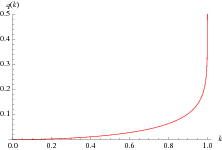

تاريخ الرياضيات

الاعداد و نظريتها

تاريخ التحليل

تار يخ الجبر

الهندسة و التبلوجي


الرياضيات في الحضارات المختلفة

العربية

اليونانية

البابلية

الصينية

المايا

المصرية

الهندية


الرياضيات المتقطعة

المنطق

اسس الرياضيات

فلسفة الرياضيات

مواضيع عامة في المنطق


الجبر

الجبر الخطي

الجبر المجرد

الجبر البولياني

مواضيع عامة في الجبر

الضبابية

نظرية المجموعات

نظرية الزمر

نظرية الحلقات والحقول

نظرية الاعداد

نظرية الفئات

حساب المتجهات

المتتاليات-المتسلسلات

المصفوفات و نظريتها

المثلثات


الهندسة

الهندسة المستوية

الهندسة غير المستوية

مواضيع عامة في الهندسة

التفاضل و التكامل


المعادلات التفاضلية و التكاملية

معادلات تفاضلية

معادلات تكاملية

مواضيع عامة في المعادلات


التحليل

التحليل العددي

التحليل العقدي

التحليل الدالي

مواضيع عامة في التحليل

التحليل الحقيقي

التبلوجيا

نظرية الالعاب

الاحتمالات و الاحصاء

نظرية التحكم

بحوث العمليات

نظرية الكم

الشفرات

الرياضيات التطبيقية

نظريات ومبرهنات


علماء الرياضيات

500AD

500-1499

1000to1499

1500to1599

1600to1649

1650to1699

1700to1749

1750to1779

1780to1799

1800to1819

1820to1829

1830to1839

1840to1849

1850to1859

1860to1864

1865to1869

1870to1874

1875to1879

1880to1884

1885to1889

1890to1894

1895to1899

1900to1904

1905to1909

1910to1914

1915to1919

1920to1924

1925to1929

1930to1939

1940to the present

علماء الرياضيات

الرياضيات في العلوم الاخرى

بحوث و اطاريح جامعية

هل تعلم

طرائق التدريس

الرياضيات العامة

نظرية البيان
Nome
المؤلف:
Abramowitz, M. and Stegun, I. A.
المصدر:
Handbook of Mathematical Functions with Formulas, Graphs, and Mathematical Tables, 9th printing. New York: Dover
الجزء والصفحة:
...
30-9-2019
4076
Nome

Given a Jacobi theta function, the nome is defined as
 |
 |
 |
(1) |
 |
 |
 |
(2) |
 |
 |
 |
(3) |
(Borwein and Borwein 1987, pp. 41, 109 and 114), where  is the half-period ratio,
is the half-period ratio,  is the complete elliptic integral of the first kind, and
is the complete elliptic integral of the first kind, and  is the elliptic modulus. The nome is implemented in the Wolfram Language as EllipticNomeQ[m].
is the elliptic modulus. The nome is implemented in the Wolfram Language as EllipticNomeQ[m].
Extreme care is needed when consulting the literature, as it is common in the theory of modular functions (and in particular the Dedekind eta function) to use the symbol  to denote
to denote  , i.e., the square of the usual nome (e.g., Berndt 1993, p. 139). In this work, the modular version of
, i.e., the square of the usual nome (e.g., Berndt 1993, p. 139). In this work, the modular version of  is denoted
is denoted
 |
(4) |
(e.g., Borwein and Borwein 1987, p. 118).


The nome in plotted above in the complex  -plane.
-plane.
Various notations for Jacobi theta functions involving the nome include
 |
(5) |
where  is the half-period ratio (Whittaker and Watson 1990, p. 464) and
is the half-period ratio (Whittaker and Watson 1990, p. 464) and
 |
(6) |
Special values include
 |
 |
 |
(7) |
 |
 |
 |
(8) |
 |
 |
 |
(9) |
The nome has Maclaurin series in parameter  given by
given by
 |
(10) |
(OEIS A002639 and A119349).
The nome has derivative
![(dq(m))/(dm)=(pi^2q(m))/(4(1-m)m[K(m)]^2),](http://mathworld.wolfram.com/images/equations/Nome/NumberedEquation5.gif) |
(11) |
where  is a complete elliptic integral of the first kind and
is a complete elliptic integral of the first kind and  is the elliptic modulus.
is the elliptic modulus.
There exists a nonlinear third-order differential equation
 |
(12) |
for  (Bertrand and Zudilin 2000; Trott 2006, pp. 29-31).
(Bertrand and Zudilin 2000; Trott 2006, pp. 29-31).
REFERENCES:
Abramowitz, M. and Stegun, I. A. (Eds.). Handbook of Mathematical Functions with Formulas, Graphs, and Mathematical Tables, 9th printing. New York: Dover, p. 591, 1972.
Berndt, B. C. Ramanujan's Theory of Theta-Functions, Theta Functions: from the Classical to the Modern. Providence, RI: Amer. Math. Soc., pp. 1-63, 1993.
Bertrand, D.; and Zudilin, W. "On the Transcendence Degree of the Differential Field Generated by Siegel Modular Forms." 23 Jun 2000. http://arxiv.org/abs/math.NT/0006176.
Borwein, J. M. and Borwein, P. B. Pi & the AGM: A Study in Analytic Number Theory and Computational Complexity. New York: Wiley, 1987.
Bramhall, J. N. "An Iterative Method for Inversion of Power Series." Comm. ACM 4, 317-318, 1961.
Ferguson, H. R. P.; Nielsen, D. E.; and Cook, G. "A Partition Formula for the Integer Coefficients of the Theta Function Nome." Math. Comput. 29, 851-855, 1975.
Fettis, H. E. "Note on the Computation of Jacobi's Nome and Its Inverse." Computing 4, 202-206, 1969.
Fletcher, A. §III in "Guide to Tables of Elliptic Functions." Math. Tables Other Aids Computation 3, 229-281, 1948.
"Guide to Tables." §III in Math. Tables Other Aids Computation 3, 234, 1948.
Hermite, C. Oeuvres, Vol. 4. Paris: Gauthier-Villars, p. 477, 1917.
Lowan, A. N.; Blanch, G.; and Horenstein, W. "On the Inversion of the  -Series Associated with Jacobian Elliptic Functions." Bull. Amer. Math. Soc. 48, 737-738, 1942.
-Series Associated with Jacobian Elliptic Functions." Bull. Amer. Math. Soc. 48, 737-738, 1942.
Sloane, N. J. A. Sequences A002639/M5108 and A119349 in "The On-Line Encyclopedia of Integer Sequences."
Tannery, J. and Molk, J. Eléments de la théorie des fonctions elliptiques, Vol. 4. Paris: Gauthier-Villars, p. 141, 1902.
Trott, M. The Mathematica GuideBook for Symbolics. New York: Springer-Verlag, 2006. http://www.mathematicaguidebooks.org/.
Wang, Z. X. and Guo, D. R. Special Functions. Singapore: World Scientific, p. 512, 1989.
Whittaker, E. T. and Watson, G. N. A Course in Modern Analysis, 4th ed. Cambridge, England: Cambridge University Press, 1990.
 الاكثر قراءة في التفاضل و التكامل
الاكثر قراءة في التفاضل و التكامل
 اخر الاخبار
اخر الاخبار
اخبار العتبة العباسية المقدسة

الآخبار الصحية















 قسم الشؤون الفكرية يصدر كتاباً يوثق تاريخ السدانة في العتبة العباسية المقدسة
قسم الشؤون الفكرية يصدر كتاباً يوثق تاريخ السدانة في العتبة العباسية المقدسة "المهمة".. إصدار قصصي يوثّق القصص الفائزة في مسابقة فتوى الدفاع المقدسة للقصة القصيرة
"المهمة".. إصدار قصصي يوثّق القصص الفائزة في مسابقة فتوى الدفاع المقدسة للقصة القصيرة (نوافذ).. إصدار أدبي يوثق القصص الفائزة في مسابقة الإمام العسكري (عليه السلام)
(نوافذ).. إصدار أدبي يوثق القصص الفائزة في مسابقة الإمام العسكري (عليه السلام)


















